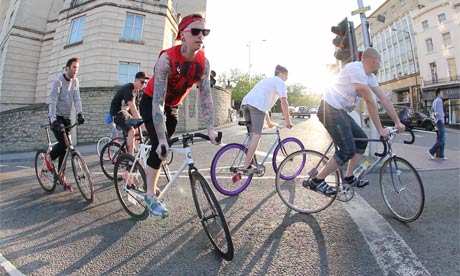
Cycling and art have a long history. For Toulouse-Lautrec, track racing in 1890's Paris was an essential part of the city's vivid twilight. Duchamp's bicycle wheel is a powerful symbol: like his Fountain (the urinal), it is both everyday and a little bit subversive.
Since its invention, the bike has stoked the passion of diverse artists, some for the circus hustle of the race, others the egalitarian potency of the original and best mass transport. Last week's Cyclescreen 2011, a bicycle film festival enjoying a successful second year at the Watershed in Bristol, presented exciting new work and some of the best classic cycling films.
The best cycling films capture the anarchic buzz of sleepy provincial town transformed into gladiatorial grandstand, and the short films Pour un Maillot Jaune, by Claude Lelouch, and Vive le Tour, by Louis Malle, achieve this very vividly. Both films are slickly new wave in style; though typical new wave features like hand-held shooting, jump cutting and a non-professional cast are difficult to avoid when filming The Tour de France.
Both films emphasise the subversive carnival of the race in a less stage-managed age, with multiple scenes of urination en route, and the riders looting a roadside cafe.
The masterpiece of bike race filming is undoubtedly Jorgen Leth's A Sunday in Hell, a documentary about the 1976 Paris-Roubaix race. The film is still used, Leth explained at the festival, by professional cyclists preparing for the race, yet so deftly is the competition between favourites narrated that the drama works for viewers with no interest in cycling. The range of Leth's technique, including a choir chanting "enfer" ("hell") in the background and the slow-motion sequences of the bikes bouncing along the notorious cobbled track, is stunning. But most impressive is the breadth of setting - including a French printers' strike disrupting the start and the carnival atmosphere in the crowd - which show the race, for all of its sporting prowess, as part of the fabric of French life.
Mainstream cinema has also found the bike a potent icon. For Italian neo-realist director De Sica , the bike in his 1948 film Bicycle Thieves is the key metaphor for opportunity in a society still devastated by war; the theft of the bike begins a spiral of both moral and economic decline.
In class-riven Britain, the bike has often been a lazy visual shorthand for working class. As Iain Sinclair has pointed out in the LRB recently, the first episode of Coronation Street featured the snobbish Ken Barlow "paralysed by pretension ... outraged when his father and brother mend a puncture on the carpet, in front of the living-room fire."
Fortunately, some directors with an interest in cycling have explored the theme in more interesting ways. Sir Ridley Scott's first film, Boy and Bicycle is a kind of stream-of-consciousness exploration of a the boy's thoughts about growing up in industrial Hartlepool, in which his bike is both literal and metaphorical means of exploration. Scott's company, RSA Associates, has recently made a series of shorts for clothing manufacturer Rapha.
Rapha is not alone in rejuvenating British cycling culture. Cyclescreen's newest film B÷IKZM÷IND (phonetic abbreviation of Bristol phrase 'nice bikes mind') told the story of the Bristol fixed gear scene, which has exploded in popularity recently, as it has in many cities. No longer just about couriers squirming through fag-paper gaps in the traffic, fixed gear riders run communal events, and the scene engages large numbers of mainly young people.
Resurgence in the cultural profile of cycling in Britain has been swift, and recent. Speaking to Cyclescreen, Guardian writer William Fotheringham recalled how, 10 years ago, no publisher was interested in a book on Lance Armstrong's return to cycling after cancer treatment. Today there are numerous books about Armstrong, and the market in cycling books is booming. Next month's Intelligence Squared debate about cycling culture features writers on a par with Europeans like Leth, Roland Barthes and novelist Antoine Blondin, who have written seriously about cycling culture.
The bike is still prominent in conceptual art. Turner Prize-winning artist Simon Starling's most distinctive bike-based work, the Five-Man Pedersen , draws on his interest in the technical structures, but, with its five riders together, also represents the bike very powerfully as icon of community. Even more recently, the bike as catalyst of urban creativity is celebrated in the Papergirl project of Berlin , Manchester and Bristol .
No other icon in sport or transport has retained such constant or potent significance. The car, once all open road and opportunity, now evokes the dystopia of Jeremy Clarkson and carmageddon . The train has surrendered its Brief Encounter romance to the absurdity of leaves on the line, and the misery of the sweaty commute.
Speaking to Cyclescreen, writer Rob Penn pointed out that the introduction of the safety bicycle in the 1880s was a revolution not just in transport but society, bringing health, freedom and opportunity to millions. 125 years on, as cycling for work, leisure and health increases, the revolution continues.

